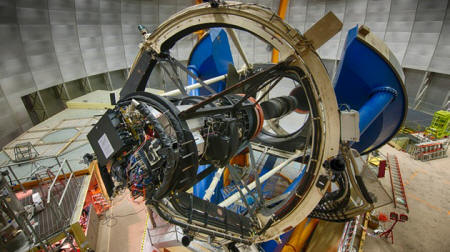High in the Chilean Andes, a massive project to probe the nature of dark energy has begun.
The Dark Energy Survey (DES) launched on 31 August at the 4-metre Blanco telescope at the Cerro Tololo Inter-American Observatory. It is one of several new pushes to explore the physical properties of dark energy, the mysterious force that is driving the universe to expand at an ever-faster rate.
Over the course of five years, the DES will map 300 million galaxies over one-eighth of the night sky.
Its backbone is a 570-megapixel digital camera (pictured, right), designed to capture sharp images of galaxies and galaxy clusters. Such high resolution is essential because the DES measures weak gravitational lensing, the phenomenon in which light from distant cosmic objects is subtly distorted by the gravity of matter between them and Earth.
Weak lensing can be hard to spot. A competing Japanese-led survey, which uses the Hyper Suprime-Cam in Hawaii, relies on an even more detailed, 870-megapixel camera. That camera is mounted on a larger machine, the 8.2-metre Subaru telescope, and so it can image fainter galaxies than the DES can.
The DES covers more area on the sky, however. Both surveys aim to measure enough weak lensing to map matter across the universe - a three-dimensional web that can reveal the fingerprints of dark energy through time.
Along with weak lensing, the DES has a couple of other tools in its arsenal.
To beef up the matter map, it will count galaxy clusters at different distances from Earth. And it will probe for distant supernovae, whose otherwise reference light is dimmed as the universe expands.
This technique was originally used to discover the accelerating cosmic expansion, and netted its scientists the 2011 Nobel Prize in physics.
The DES also hopes to muscle in on the territory of studying sound waves in the early universe. Its sky maps could reveal the effects of pressure waves frozen in place some 370,000 years after the big bang. Those results, in turn, could shed light on how the expansion rate of the universe changed over time, presumably driven by dark energy.
But other approaches have a head start in this arena. The ongoing BOSS survey and its planned successor, BigBOSS, focus on taking spectra of these acoustic waves, known as baryon acoustic oscillations.
BOSS has already mapped these cosmic ripples and provided some of the tightest constraints on dark energy through time.

